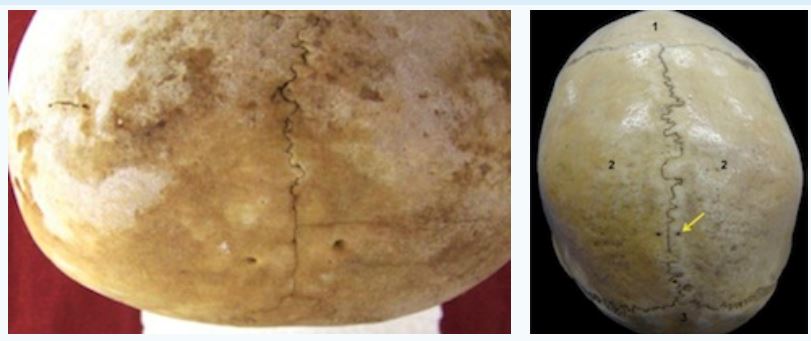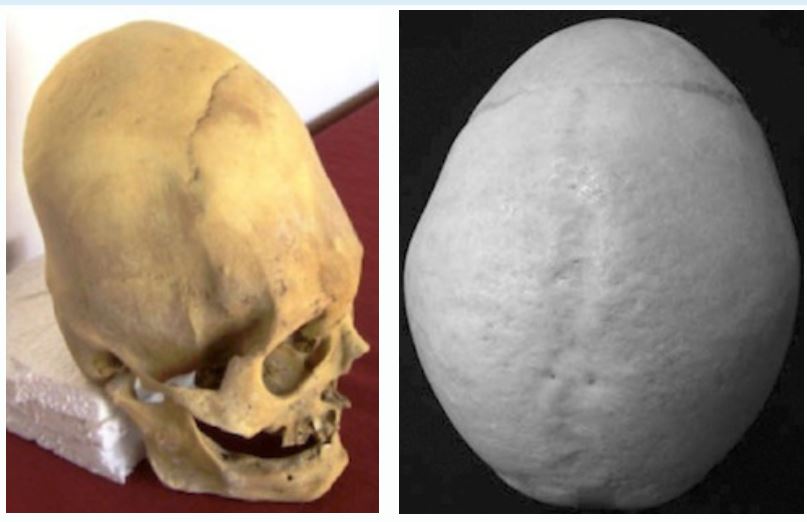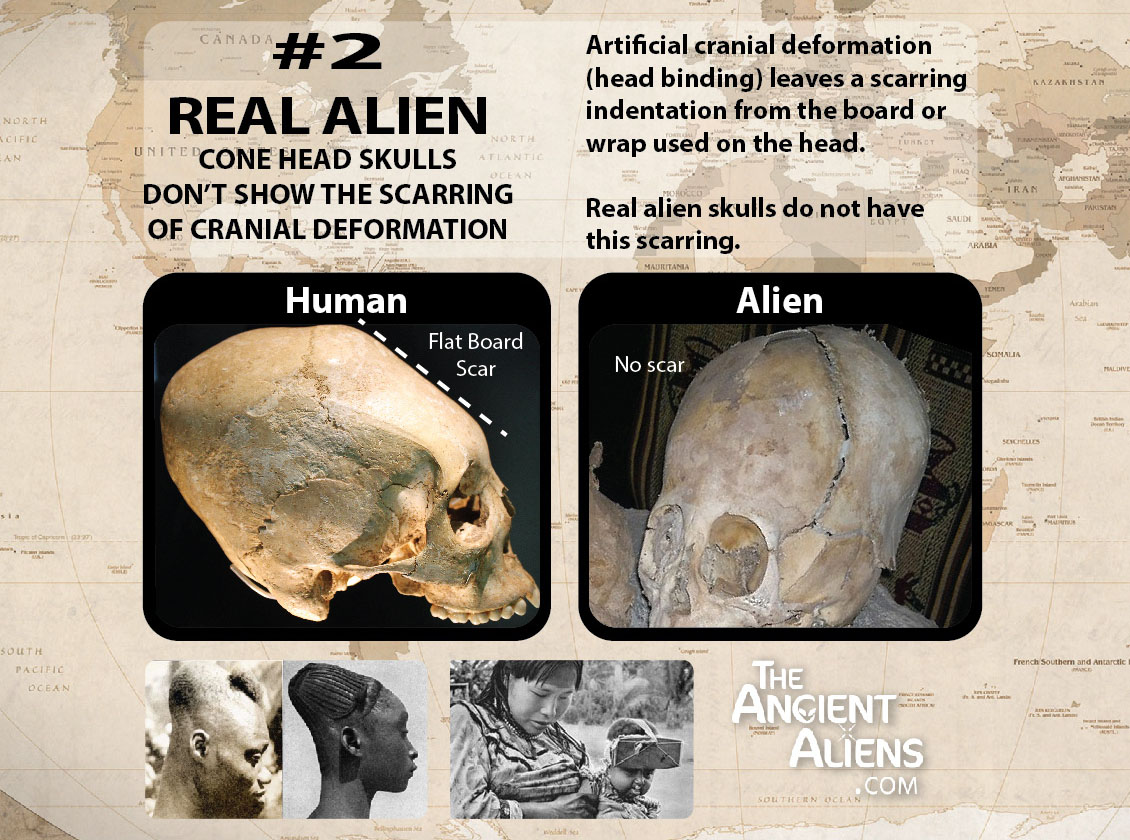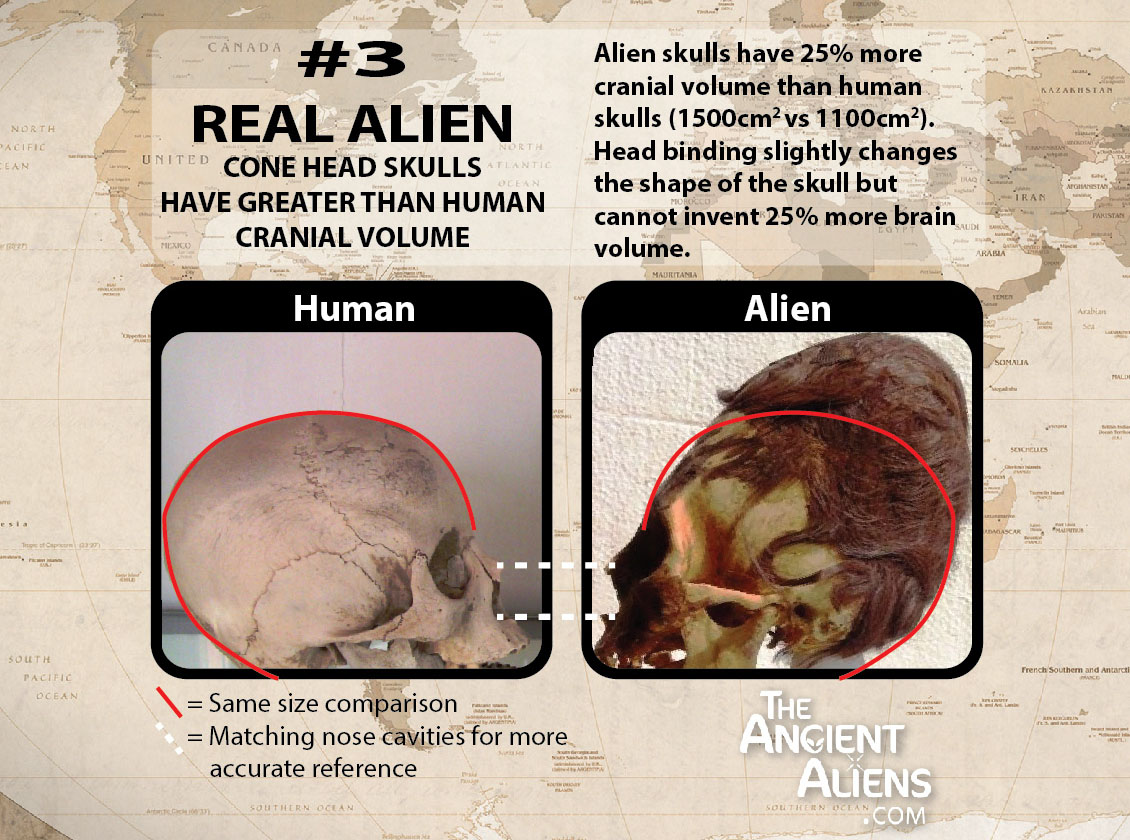It looks like you're using an Ad Blocker.
Please white-list or disable AboveTopSecret.com in your ad-blocking tool.
Thank you.
Some features of ATS will be disabled while you continue to use an ad-blocker.
share:
KanuTruth
#5 Alien Cone Head Skulls Have Only 2 Cranial Plates
The human skull has 3 major bones (plates) that comprise the spherical shape of the skull. They are the frontal bone, the parietal bones (left and right hemispheres). (I’m leaving out all the other smaller bones in this comparison). The main difference in cone head skulls is the ones believed to be truly alien in origin have only two major skull bones. Still others have four skull bones. In both cases, this differs from human skulls. This difference cannot be attributed to cranial deformation. Wrapping the skull at infancy to change its shape cannot change the genetic makeup of human skull bones. Again, this is a natural occurrence as directed by the being’s DNA. - See more at: www.abovetopsecret.com...
This is something that has puzzled me:
Humans are unique when it comes to our skull plating. The reason we got three plates was that evolution needed to find a way of squeezing human's large heads through the birth canal. The solution was to break our skull into three platest that deform during birth without damaging the brain or the birth canal, thus enabling humans to be born with such large brains. After birth the skull reshapes to its original form, but the plates does not fuze together in the first years so that the brain can grow unrestricted from the size of the skull.
So, if the people with the elongated skulls only have two plates, then how can they possibly have been born with such large brains? Could the same principle of deforming the skull work with just two plates ? Or are we looking at alien creatures that are not born through a birth canal at all but through some other mean? Perhaps they are born from an egg or manufactured in a lab?
-MM
edit on 6-4-2014 by MerkabaMeditation because: (no reason given)
reply to post by KanuTruth
This information would only be valuable if any skulls came from aliens. Since none do what are people to do with this info?
This information would only be valuable if any skulls came from aliens. Since none do what are people to do with this info?
Great post. Yet I still see no proof of the skulls being alien. How bout an extinct species of hominid. Maybe they ended up like the Taino indians
of the Caribbean. They did not go "poof" in one night. They were assimilated into the mix of the Americas.
edit on 6-4-2014 by dIS3MBoW3MeNt
because: (no reason given)
reply to post by Riddles
Why would you think this would be used to clone humans when your source clearly states that the procedure would be fatal to higher animal lifeforms? You posted the relevant paragraph that contained that very statement.
Why would you think this would be used to clone humans when your source clearly states that the procedure would be fatal to higher animal lifeforms? You posted the relevant paragraph that contained that very statement.
double post
edit on 6-4-2014 by PhoenixOD because: (no reason given)
Well it took only a few mins in google to find out some real info about the claims of the so called cone heads alien skulls.
It has been claimed bu the ancient aliens site and the book by Childress that 2 holes in the skull indicate a skull MUST be alien.. But in fact they called parietal emissary foramina and are totally normal and can be seen in normal human skulls.

source
Its also be claimed that less than 3 skull plates MUST prove a skull is alien when in fact its a condition called sagittal synostosis that is present in some human skulls.

source
source
Plus we now know that the claims about DNA sited at the end of the op's post are completely unreliable as they have not been produced by a professional laboratory, checked or published. The only DNA test done by professional world class labs who specialize in dealing with ancient DNA analysis prove the DNA to be human.
I don't blame people for being fooled by the ancient aliens site , Brien Foerster or childress's books because they make their living from taking half truths and twisting them into lies about aliens and selling them to the general public. They are good at it as its their job but in reality they are snake oil con men at best.
It has been claimed bu the ancient aliens site and the book by Childress that 2 holes in the skull indicate a skull MUST be alien.. But in fact they called parietal emissary foramina and are totally normal and can be seen in normal human skulls.

On the left is a skull from a Paracas grave. Oriented the same way, on the right, is a modern adult human skull showing that openings for veins called parietal foramina (arrow) are normal variations. The sagittal suture is the wavy line between the two parietal bones (2). The frontal bone (the forehead) is labeled 1 and is not included in the Paracan photograph. The occipital bone is labeled 3. Images: Left from Brien Foerster through www.grahamhancock.com; Right from A. R. Freire et al., “Emissary Foramens of the Human Skull: Anatomical Characteristics and its Relations with Clinical Neurosurgery,” International Journal of Morphology 31, no. 1:287–292, dx.doi.org/10.4067/S0717-95022013000100045.
source
Its also be claimed that less than 3 skull plates MUST prove a skull is alien when in fact its a condition called sagittal synostosis that is present in some human skulls.

On the left is a skull from a Paracas grave. The sagittal suture appears to be missing. On the right is a modern human skull from a person whose sagittal suture fused prematurely and is obliterated. Images: Left from Brien Foerster through www.grahamhancock.com; Right from A. R. Freire et al., “Emissary Foramens of the Human Skull: Anatomical Characteristics and its Relations with Clinical Neurosurgery,” International Journal of Morphology 31, no. 1:287–292, dx.doi.org/10.4067/S0717-95022013000100045.
source
Foerster claims the cranial capacity of these skulls is much too large for a human— “in some cases 2.5 times larger than a conventional modern human skull.”1 He says he’s talked to “a doctor” who assured him the large volume could not be attributed to ritual cranial deformation and must therefore be genetic. In reality, the average cranial capacity of the skulls from the necropolis is about 1600 cc. Normal human cranial capacity varies widely, with 1350 cc being the modern average, Cro-Magnon brain size being about 1600 cc, and Homo erectus being substantially smaller than that of modern humans. While above average for modern humans, this volume is not abnormal for humans.
Foerster notes the skulls have two abnormal holes and “only one parietal plate” instead of the usual two. The latter is known as sagittal synostosis—premature fusion of the sagittal suture line that runs across the top of the skull. This suture knits the parietal bones together, but premature fusion can obliterate the line. The little holes are a common human variation. Called parietal emissary foramina, they allow the passage of veins connecting the venous system inside the skull to that on the outside.
source
Plus we now know that the claims about DNA sited at the end of the op's post are completely unreliable as they have not been produced by a professional laboratory, checked or published. The only DNA test done by professional world class labs who specialize in dealing with ancient DNA analysis prove the DNA to be human.
I don't blame people for being fooled by the ancient aliens site , Brien Foerster or childress's books because they make their living from taking half truths and twisting them into lies about aliens and selling them to the general public. They are good at it as its their job but in reality they are snake oil con men at best.
edit on 6-4-2014 by PhoenixOD because: (no reason given)
reply to post by PhoenixOD
You mean to tell me that even human skulls are subject to human diversity?? By the Gods!
I don't really know how they separated the 'alien' skulls from the human elongated ones in the first place. Its sort of like they just said "ok, these are different," and then found some arbitrary features that the other skulls didn't have.
You mean to tell me that even human skulls are subject to human diversity?? By the Gods!
I don't really know how they separated the 'alien' skulls from the human elongated ones in the first place. Its sort of like they just said "ok, these are different," and then found some arbitrary features that the other skulls didn't have.
I think the humans who have these funky skulls did so as to show admiration to the
visitors...Already mentioned?
Where did the idea originate?
Where did the idea originate?
hellobruce
Zanti Misfit
reply to post by KanuTruth
There is also Evidence from the Scientific Community that some of these Skull Cavities hold a 25 Percent Larger Brain Mass
Do you have a valid source got that claim?
THE SCIENTIFIC COMMUNITY!!
Geeze... Some people don't read...
I'm surprised energy beings, or people with higher consciousness haven' t been brought into the convo, like in some threads.
O wait, energy beings/god don't bleed, or leave bones.
O wait, energy beings/god don't bleed, or leave bones.
It actually is interesting that these things have been largely ignored. S&f
AutumnWitch657
reply to post by Riddles
Why would you think this would be used to clone humans when your source clearly states that the procedure would be fatal to higher animal lifeforms? You posted the relevant paragraph that contained that very statement.
I also stated...
"I suspect that if mutated human DNA was the actual goal, colchicine would be very useful, though it would probably require one or more additional steps to ensure that the resulting embryo would survive. "
As you will note, I said that I thought "additional steps" would probably be required in order to get the embryo to live.
And I also didn't tell you the whole story. I posted pretty much the same info about colchicine years ago on another forum, when I suddenly began receiving private messages from one of the forum members, a gentleman working in a modern-day bio-genetics lab.
The guy just read me the riot act for supposedly posting "classified information." He even threatened to track down my real identity and have my "security clearance revoked."
I was just floored. I'm not a geneticist, have never had a security clearance, and told him I'd read about it in a book and put it together with things said in Greek mythology. He said that it was the authors of the book then, the Landsburgs, who were going to be in trouble. I mean this guy was really mad as all get out!
That really raised some red flags on my part, as you might imagine it would. Since then I have tracked online articles about colchicine. A lot is said about it in relation to developing mutated plant genetics, but I don't find a word about it in relation to animal and human genetic manipulation.
So either colchicine is a complete bust in the manipulation of human & animal DNA, or modern-day geneticists have figured out how to use it in a way that allows a mutated embryo to survive.
And if it's the later that is true, then I suspect that anything referencing colchicine and the manipulation of mutated human or animal DNA would indeed be "classified."
The whole thing really made me wonder what in the hell is going on in some of our modern-day genetics labs.
There's been a whole lot of creepy looking "must be alien" types of creatures being reported around the world and I've got a sneaking hunch they maybe aren't so alien after all, but something being cooked up in somebody's bio-genetics lab.
And, based on the old Sumerian "Enki and Ninmah" text that I sited earlier, you will note that Enki & Ninmah were evidently ALSO successful in getting horribly mutated human beings to survive...
edit on 6-4-2014 by Riddles because: (no reason given)
edit on 6-4-2014 by Riddles because: Typos. It's always typos
reply to post by Riddles
In support of your argument,
You nailed it pretty good. I don't think that the goal would be to bring an embryo to term, but to harvest polyploid cells. So yes, it may require several steps after the application of colchine but I think the goal is new chromosomal information, not embryos fostered from the "original" "colchinated" cells.
Your speculation regarding animal polyploiody is clearly just that: speculation, it does not make or break your argument about the colchine, Colchis and Jason and The Argonauts, which is very cool.
In support of your argument,
You nailed it pretty good. I don't think that the goal would be to bring an embryo to term, but to harvest polyploid cells. So yes, it may require several steps after the application of colchine but I think the goal is new chromosomal information, not embryos fostered from the "original" "colchinated" cells.
Your speculation regarding animal polyploiody is clearly just that: speculation, it does not make or break your argument about the colchine, Colchis and Jason and The Argonauts, which is very cool.
reply to post by KanuTruth
It seems when people want to believe something their observational skills go down the toilet !
Strange that both skulls are not shown in profile don't you think.

Strange how when shown in profile the supposed alien skull seems to have a flat board scar like the human skull in the picture above!!!!

It seems when people want to believe something their observational skills go down the toilet !
Strange that both skulls are not shown in profile don't you think.

Strange how when shown in profile the supposed alien skull seems to have a flat board scar like the human skull in the picture above!!!!

reply to post by wmd_2008
The cone-head skulls, particularly those found in Peru, have been the subject of much scientific research and discussion since the Internet first went online.
It has long been known that what makes these skulls such an enigma is the fact that the brain cavities of these skulls is roughly 25% larger than that of a normal human being.
Applying boards to a baby's skull CAN produce the same visual effect, however it DOES NOT increase cranial size!
Hence the mystery...
The cone-head skulls, particularly those found in Peru, have been the subject of much scientific research and discussion since the Internet first went online.
It has long been known that what makes these skulls such an enigma is the fact that the brain cavities of these skulls is roughly 25% larger than that of a normal human being.
Applying boards to a baby's skull CAN produce the same visual effect, however it DOES NOT increase cranial size!
Hence the mystery...
Riddles
reply to post by wmd_2008
The cone-head skulls, particularly those found in Peru, have been the subject of much scientific research and discussion since the Internet first went online.
It has long been known that what makes these skulls such an enigma is the fact that the brain cavities of these skulls is roughly 25% larger than that of a normal human being.
Applying boards to a baby's skull CAN produce the same visual effect, however it DOES NOT increase cranial size!
Hence the mystery...
There is no mystery as the normal size of a human skull varies enough to allow this as i have shown above
Foerster claims the cranial capacity of these skulls is much too large for a human— “in some cases 2.5 times larger than a conventional modern human skull.”1 He says he’s talked to “a doctor” who assured him the large volume could not be attributed to ritual cranial deformation and must therefore be genetic. In reality, the average cranial capacity of the skulls from the necropolis is about 1600 cc. Normal human cranial capacity varies widely, with 1350 cc being the modern average, Cro-Magnon brain size being about 1600 cc, and Homo erectus being substantially smaller than that of modern humans. While above average for modern humans, this volume is not abnormal for humans.
The people trying to tell you these skulls are alien are con man just after money.
edit on 6-4-2014 by PhoenixOD because: (no reason given)
Riddles
It has long been known that what makes these skulls such an enigma is the fact that the brain cavities of these skulls is roughly 25% larger than that of a normal human being.
We keep hearing that claim, but nothing valid to actually back it up...... infact the evidence shows otherwise....
draknoir2
THE SCIENTIFIC COMMUNITY!!
Exactly who in the scientific community, and what are their names and qualifications....?
edit on 6-4-2014 by hellobruce because: (no reason
given)
The OP believes "Foerster is a con man."
I have never read Foerster's research and I don't have a clue who he is.
I have however read the research of a team of investigators who went down to Peru a number of years ago & spent considerable time and money measuring the cranial capacity of the cone-heads, along with a number of other huge and misshappened skulls that are on display in the Peruvian museums.
I don't have any idea where the results of that investigation has gone to today as the site is no longer available. If I knew I would post the link.
However, I was in e-mail contact with one of the scientists on that team and I am personally convinced that their research was exacting and trustworthy. Their research was online in the early 90s.
Foerster may be a con man, but the people who did the original research weren't.
I have never read Foerster's research and I don't have a clue who he is.
I have however read the research of a team of investigators who went down to Peru a number of years ago & spent considerable time and money measuring the cranial capacity of the cone-heads, along with a number of other huge and misshappened skulls that are on display in the Peruvian museums.
I don't have any idea where the results of that investigation has gone to today as the site is no longer available. If I knew I would post the link.
However, I was in e-mail contact with one of the scientists on that team and I am personally convinced that their research was exacting and trustworthy. Their research was online in the early 90s.
Foerster may be a con man, but the people who did the original research weren't.
edit on 6-4-2014 by Riddles because: (no reason given)
reply to post by Riddles
Ahhh! Found it!!! Here's the Link:
www.world-mysteries.com...
Lumir G. Janku is the man I was in contact with.
Ahhh! Found it!!! Here's the Link:
www.world-mysteries.com...
Lumir G. Janku is the man I was in contact with.
new topics
-
New Disney Star Wars Films Failing Test of Time?
Movies: 8 hours ago
top topics
-
Mass UAP events. DC. Machester Airport, UFOs over sub base in CT, Nuke bases.
Aliens and UFOs: 15 hours ago, 14 flags -
population madness
New World Order: 14 hours ago, 4 flags -
New Disney Star Wars Films Failing Test of Time?
Movies: 8 hours ago, 2 flags -
The Cost of True Discipleship—Count the Cost
Religion, Faith, And Theology: 13 hours ago, 1 flags
active topics
-
Mass UAP events. DC. Machester Airport, UFOs over sub base in CT, Nuke bases.
Aliens and UFOs • 22 • : awhispersecho -
New Disney Star Wars Films Failing Test of Time?
Movies • 13 • : Bluntone22 -
Results of the use of the Oreshnik missile system in Dnepropetrovsk
World War Three • 258 • : Oldcarpy2 -
population madness
New World Order • 19 • : Flyingclaydisk -
-@TH3WH17ERABB17- -Q- ---TIME TO SHOW THE WORLD--- -Part- --44--
Dissecting Disinformation • 3413 • : Thoughtful3 -
The Cost of True Discipleship—Count the Cost
Religion, Faith, And Theology • 4 • : FullHeathen -
Holy Cow! Erm...Six Legged Turkey!!
World Sports • 10 • : Flyingclaydisk -
Unidentified Flying Objects Over U.S. Military Bases in Northeast UK, as of roughly 11 a.m. CST.
Aliens and UFOs • 29 • : BeyondKnowledge3 -
Why isn't Psychiatry involved?
Social Issues and Civil Unrest • 19 • : lilzazz -
Post A Funny (T&C Friendly) Pic Part IV: The LOL awakens!
General Chit Chat • 7849 • : underpass61
